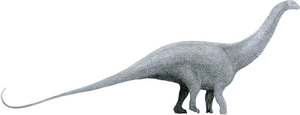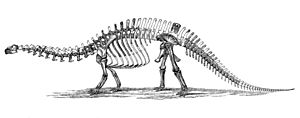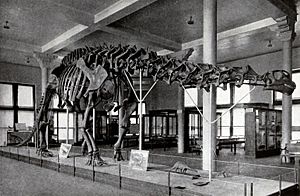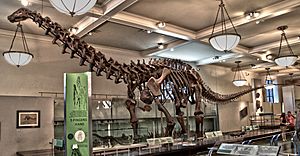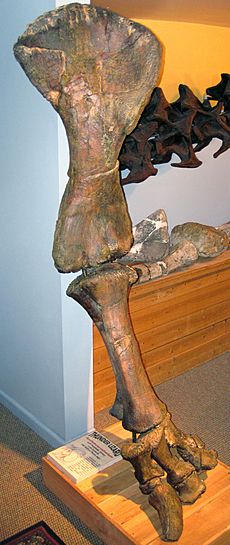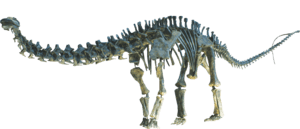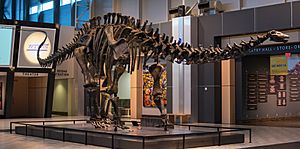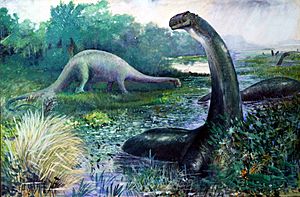Brontosaurus facts for kids
Quick facts for kids BrontosaurusTemporal range: Upper Jurassic
154–150 mya |
|
|---|---|
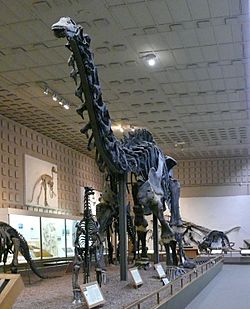 |
|
| Holotype specimen of B. excelsus Peabody Museum of Natural History |
|
| Scientific classification | |
| Kingdom: | |
| Class: | |
| Subclass: | |
| Superorder: | |
| Order: | |
| Suborder: | |
| Family: | |
| Type species | |
| Brontosaurus excelsus |
|
Brontosaurus is a type of sauropod dinosaur with a long neck. It was first named by Othniel Charles Marsh in 1879. For a long time, scientists thought Brontosaurus was actually the same as another dinosaur called Apatosaurus. In 1903, its only species was renamed A. excelsus.
However, a big study in 2015 looked closely at these dinosaurs. It found that Brontosaurus was indeed a separate and valid type of sauropod, different from Apatosaurus.
Brontosaurus belongs to the family called Diplodocidae. This group includes some of the longest creatures that ever lived on Earth. Famous members are Diplodocus, Supersaurus, and Barosaurus. Brontosaurus is very closely related to Apatosaurus.
Contents
About Brontosaurus
Brontosaurus was a huge animal that walked on four legs. It had a very long neck and a long, whip-like tail. Its front legs were a bit shorter than its back legs. The biggest type, B. excelsus, could weigh up to 15 tons. It measured up to 22 meters (72 feet) long from its head to the tip of its tail.
Scientists have not found a complete Brontosaurus skull yet. But they think it probably looked like the skull of its close relative, Apatosaurus. Like other sauropods, its neck bones were very strong. They had special shapes that made the neck wide and deep. The neck also had many air sacs inside. These air sacs helped make the neck lighter.
Brontosaurus had tall spines on its backbones. These spines made up more than half the height of each bone. Its tail was thinner than other dinosaurs in its family. This was because the spines on its tail bones got shorter quickly. Brontosaurus also had very long ribs. This gave it a very deep chest. The very end of its tail was like a whip.
Its leg bones were also very strong. Each front foot had one large claw. The first three toes on each back foot also had claws. Scientists believe this single front claw was used for grabbing things. Maybe it helped the dinosaur hold onto tree trunks when it stood up.
Brontosaurus History
In 1879, a professor named O.C. Marsh found a large dinosaur skeleton. He found it in rocks in Wyoming. He thought it was a completely new type of dinosaur. So, he named it Brontosaurus excelsus. The name means "thunder lizard." Brontosaurus comes from Greek words for "thunder" and "lizard." Excelsus is Latin for "noble" or "high."
At this time, Marsh and another scientist, Edward Drinker Cope, were in a big competition. They were both trying to find and name the most fossils. This competition was called the "Bone Wars." Because of this, their dinosaur descriptions were sometimes done very quickly.
In 1903, another scientist named Elmer Riggs said that Brontosaurus was not different enough from Apatosaurus. He decided that Brontosaurus should be called Apatosaurus excelsus instead. Riggs said that since Apatosaurus was named first, that name should be used. Even so, when the American Museum of Natural History put together its first sauropod skeleton, they labeled it "Brontosaurus."
In 1905, the American Museum of Natural History showed off its Brontosaurus skeleton. It was the first time a sauropod skeleton was put together for display. Many of the bones were from one dinosaur. But some parts, like the feet and tail, were from other dinosaurs. They also had to sculpt a head for it. This sculpted head was based on bones from a different dinosaur, probably Camarasaurus. This was because they couldn't find a Brontosaurus skull.
In 1909, an Apatosaurus skull was finally found. It was found near a skeleton that was named Apatosaurus louisae. This skull looked a lot like the skull of Diplodocus. Many scientists thought this skull belonged to Apatosaurus. But some, like Henry Fairfield Osborn, did not agree.
It wasn't until the 1970s that scientists John Stanton McIntosh and David Berman confirmed it. They found that Apatosaurus (and Brontosaurus) most likely had a skull similar to Diplodocus. In 1979, the Carnegie Museum put an Apatosaurus skull on its skeleton. In 1995, the American Museum of Natural History did the same. They also fixed the tail on their skeleton.
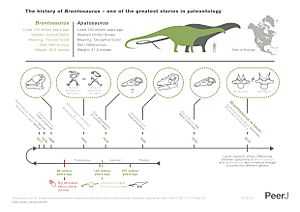
For most of the 1900s, scientists agreed that Apatosaurus and Brontosaurus were the same. The rules of naming animals meant that Apatosaurus was the official name. But in 2015, a big study by Emanuel Tschopp and his team changed things. They used a new way to compare dinosaur differences. They found that Brontosaurus was indeed a separate and valid type of dinosaur. They "brought back" the name Brontosaurus. They also moved two other species, A. parvus and A. yahnahpin, into the Brontosaurus group.
Brontosaurus Types
There are three main types, or species, of Brontosaurus:
- Brontosaurus excelsus: This is the original type of Brontosaurus. Marsh named it in 1879. The main fossil for this species is YPM 1980. The largest B. excelsus could weigh up to 15 tons and be 22 meters (72 feet) long. These fossils are found in Wyoming. They are about 152 million years old.
- Brontosaurus parvus: This species was first named Elosaurus in 1902. Later, it was moved to Apatosaurus. Then, in 2015, it was moved to Brontosaurus. Fossils include a partial skeleton of a young dinosaur found in Wyoming. Another nearly complete skeleton was found in Utah. Adult B. parvus could weigh up to 14 tons and be 22 meters (72 feet) long.
- Brontosaurus yahnahpin: This is the oldest known Brontosaurus species. It lived about 155 million years ago. It could grow up to 21 meters (69 feet) long. Its name comes from the Lakota language. It means "breast necklace," because of how some of its bones looked. This species was first called Apatosaurus yahnahpin in 1994. In 1998, a scientist thought it was even more ancient. So, he gave it a new name, Eobrontosaurus, meaning "dawn thunder lizard."
How Brontosaurus Lived
Movement and Posture
For a long time, people thought huge dinosaurs like Brontosaurus were too heavy to walk on land. They believed these dinosaurs lived partly in water, maybe in swamps. But newer discoveries show this is not true. Scientists now think sauropods were fully land animals.
Dinosaurs like Brontosaurus are often shown with their necks held high. This would let them eat leaves from tall trees. Some studies suggest their necks were not as flexible as once thought. But other studies say that most animals hold their necks up high when they are alert. They think sauropods did the same.
Footprints from sauropods show they probably walked about 20 to 40 kilometers (12-25 miles) each day. They might have been able to run up to 20 to 30 kilometers (12-19 miles) per hour. Their slow walking might be because they didn't have much muscle or spring in their steps.
The single claw on their front feet might have had different uses. Some thought it was for defense, but its shape makes that unlikely. It might have been for eating. But the most likely idea is that the claw helped them grab things, like tree trunks, when they stood up on their back legs.
Body Temperature
Scientists have studied how Brontosaurus and other large sauropods kept warm. Some think their huge size made it hard for them to cool down. This would mean they couldn't have a very fast metabolism. However, the Jurassic period was warmer than today. Also, some scientists think they had a breathing system like birds. This would help them release more heat.
Young Brontosaurus
We know about young Brontosaurus from the fossil of a young B. parvus. This fossil includes bones from its back, a hip bone, and some leg bones.
Tail Use
In 1997, a scientist named Nathan Myhrvold studied the tails of diplodocids like Brontosaurus. He used computer models. He found that their long, whip-like tails could make a cracking sound. This sound could be louder than 200 decibels. That's as loud as a cannon!
Brontosaurus Environment
Brontosaurus lived in a place called the Morrison Formation. This area had shallow seas and river sediments. It existed about 156.3 to 146.8 million years ago. This was during the Late Jurassic period. The environment was semi-dry, with clear wet and dry seasons.
The Morrison Basin, where these dinosaurs lived, stretched from New Mexico to Canada. It formed as the Rocky Mountains began to rise. Rivers carried dirt and rocks into swampy lowlands, lakes, and floodplains. This area was similar to places in Portugal and Tanzania today.
Brontosaurus might have been more of a loner than other dinosaurs in the Morrison Formation. Brontosaurus lived for a long time. Their fossils have been found in most layers of the Morrison Formation. B. excelsus fossils are found in rocks about 154–151 million years old. Older Brontosaurus fossils, from B. parvus, are also found. Fossils have been discovered in Wyoming, Colorado, Oklahoma, and Utah.
The Morrison Formation was a time and place ruled by giant sauropod dinosaurs. Other dinosaurs found there include meat-eaters like Ceratosaurus and Torvosaurus. Other plant-eaters were Apatosaurus, Brachiosaurus, Camarasaurus, and Diplodocus. There were also armored dinosaurs like Stegosaurus. Other animals included fish, frogs, turtles, and crocodiles. Plants included ferns, horsetails, and conifers.
Brontosaurus in Culture
Brontosaurus became one of the most famous dinosaurs. This happened because it took a long time for people to accept that it was the same as Apatosaurus. Also, some people insisted on keeping the name Brontosaurus. In fact, Brontosaurus is often used as a general word for "dinosaur."
Brontosaurus has appeared in many movies. One of the first was Gertie the Dinosaur in 1914. This was one of the first animated films. The 1925 silent movie The Lost World showed a Brontosaurus fighting an Allosaurus. The 1985 movie Baby: Secret of the Lost Legend is about a family of Brontosaurus found alive in Africa. These early movies helped make Brontosaurus a classic dinosaur in people's minds.
Sinclair Oil Corporation has a green dinosaur logo and mascot. This mascot is a Brontosaurus. While Sinclair used different dinosaurs at first, the Brontosaurus became their official logo because it was so popular.
Even in 1989, the United States Postal Service caused a stir. They released four dinosaur stamps, including one for Brontosaurus. People complained that using "Brontosaurus" instead of "Apatosaurus" was "fostering scientific illiteracy." The Postal Service defended itself. They said that Brontosaurus was "more familiar to the general population." They also pointed out that they called Pteranodon a "dinosaur" on the stamps, even though it was a flying reptile, not a true dinosaur.
Paleontologist Stephen Jay Gould supported the Postal Service. He even named a book Bully for Brontosaurus. He agreed that Brontosaurus is a synonym for Apatosaurus. But he noted that the name Brontosaurus has a life of its own in popular culture. The 2015 study that brought back the name Brontosaurus also created a lot of discussion. Many people, both for and against the change, shared their opinions.
Images for kids
See also
 In Spanish: Brontosaurus para niños
In Spanish: Brontosaurus para niños



